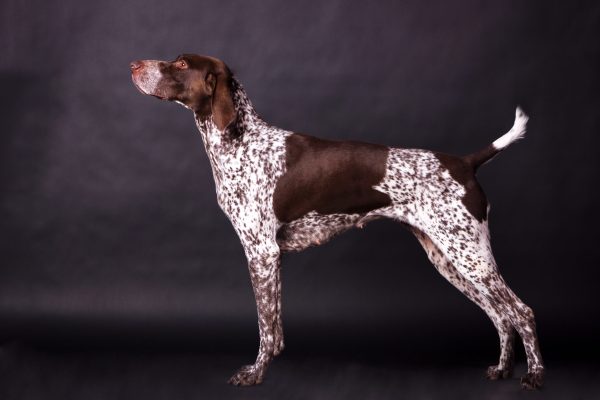
The German Shorthaired Pointer’s AKC breed standard has a clause that may seem contradictory to people new to the breed, the fancy, or anyone learning about structure. The clause (in italics) is: The dog… gives the impression of medium size, but is like the proper hunter, “with a short back, but standing over plenty of ground.”
The dog is short backed but standing over plenty of ground?
As they say, one picture is worth a thousand words. In the photo below, the white lines indicate how the dog is “short at the top,” but she covers more “real estate” than the length of her back.

Image of German Shorthaired Pointer by svetlanistaya has been edited to include the diagram
As we don’t have permission to share the original image which appears in the parent club’s Illustrated Standard, we imitated it using a stock photo and hope it’s okay to have done so because it it too educational not to share.
The standard writes that the back is short, strong, and straight with a slight rise from the root of the tail to the withers. Here we’d like to interject with some clarification. A dog’s topline isn’t the same thing as the dog’s back, nor are they interchangeable. The topline is formed by the dog’s withers, back, loin and croup, the area from the base of the dog’s neck to the base of her tail. The back is one component of the topline. Were it otherwise, the back would be the pink line, not the white.
Not all toplines are designed to be the same, nor should they be because a sighthound, for example, has a different function than a sporting breed. Were they to swap jobs, each would perform poorly because their respective backs would not accommodate the jobs they are called upon to perform.
It must be pointed out, as well, that since breeders can’t swap out parts of their dog as if they were made out of lego blocks, the overall proportions of the GSP must be correct in order to have that correct short-backed dog standing over plenty of ground. As Dr. Paul Kleeman, an early breed expert, once said: “To work right, a dog must be built right. It has to be born right.” Were the dog to have a longer back, it might be eye catching in a show ring because of a long stride associated with more rear angulation, but a longer back can be prone to injury because it is less stable. The GSP must be nimble but powerful, and a solid, balanced structure is critical to its function as a sporting breed.
We encourage you to read the Illustrated Guide for the breed because it does a great job of explaining the breed.
Top image unaltered by svetlanistaya/Adobe Stock Photo
